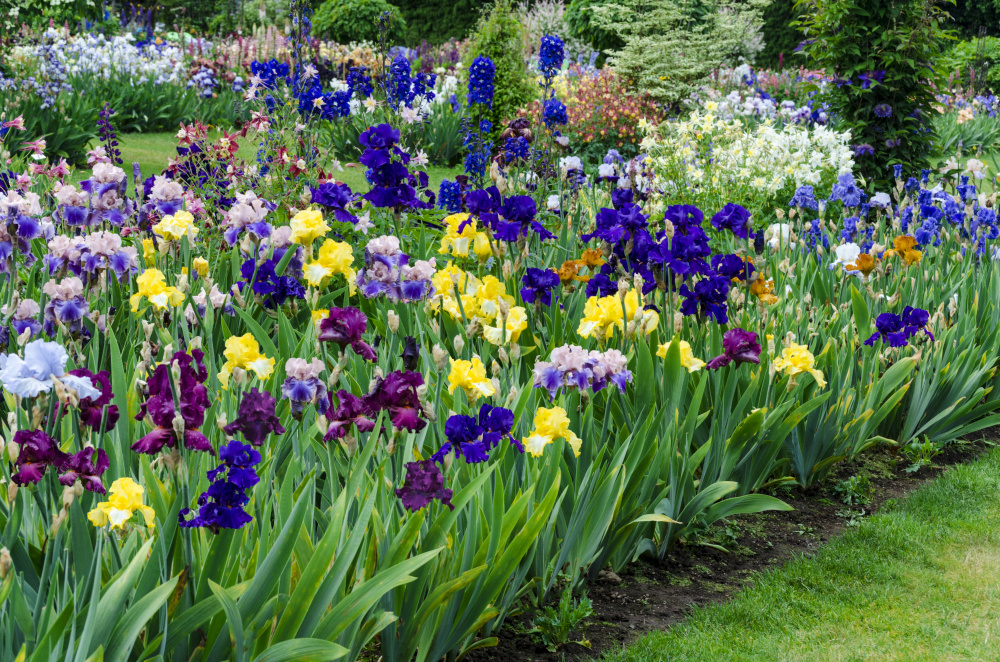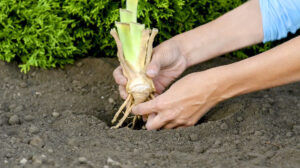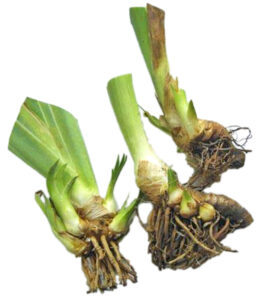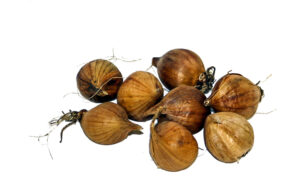When you look at the many vibrant members of the iris family, it’s not hard to see why Swedish botanist Carl Linnaeus named the group after the Greek goddess of rainbows, Iris. Members of the Iridaceae family, irises — with about 80 genera and 1,500 species — are truly a varied group, not just in the assortment of colors in which they come, but in the types of habitats they prefer, which range from desert conditions to swamps. You can find members of this diverse group in Europe, the Middle East and Northern Africa, and across North America. Growing from rhizomes or bulbs, these lovely flowers reach a variety of heights and bloom in every season, too.
Planting Irises
Rhizomatous irises which include the popular bearded iris, are typically planted with the top of the rhizome poking out just above soil level. An easy way to do this is to dig two shallow trenches with a ridge between them. Place the rhizome atop the ridge and spread its roots into the trenches. Fill the trenches with soil, then top-dress with a low-nitrogen fertilizer (high-nitrogen fertilizers will “burn” the rhizome). After the initial planting, fertilize the rhizomes each spring. Water often: Bearded irises prefer moist, well-drained soil. Do not mulch bearded irises during their growing season since the mulch can harbor disease and pests that will infect the rhizome.
Choosing an Iris for Your Garden

Plant beardless irises, which are also rhizomatous, using this same technique, but set the entire rhizome beneath the soil’s surface. Unlike their bearded cousins, many beardless iris varieties (including Japanese, Siberian, and Louisiana irises) prefer wet conditions, so they benefit from moisture-retentive mulch when they are growing. You should, however, mulch all iris varieties in winter because it will prevent frost heaving, which is the expansion and contraction of the soil’s surface due to the freezing and thawing of moisture within the soil.
Definition : Frost heaving is the expansion and contraction of the soil’s surface due to the freezing and thawing of moisture within the soil.
Bulbous irises include the popular Dutch iris, plus English and Spanish irises. Plant bulbs in a light, well-drained soil mix. If you have heavy clay soil, add some coarse sand and humus. Plant the bulbs 3-4″ deep and 4″ apart. After the plants have flowered, feed them with a high-phosphorus fertilizer to encourage bulb growth.

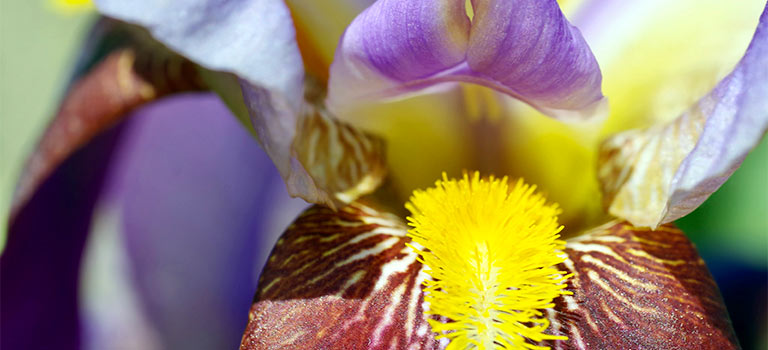
Iris Flower Parts
Irises have six petals. The three larger petals, which generally extend below the flower head, are called falls. This is where the “beards” of bearded iris, or the “crests” of a crested iris, are found. The “shoulders” of the falls are called hafts. The style arms are smaller petallike parts over the falls; these have the stigmas (where pollen is deposited).
The other three petals are often smaller, and usually extend above or to the side of the flower head; these are called standards.

Dividing Irises
Over time, iris beds, whether planted with rhizomes or bulbs, can become crowded and blooms may suffer. You can get your plants back to blooming beautifully by dividing them. In late summer or early fall, carefully lift the entire clump with a garden fork. Using a sharp knife, cut apart the new, younger sections from the original center rhizomes, then replant, either in the same spot, a new spot, or both. You may want to let the rhizomes dry in the sun for a day before replanting.
Divide bulbous irises in early autumn after the plants have finished blooming, but while they still have foliage. Dig them up gently (any cuts or bruises can invite diseases) and, with your hands, carefully pull the bulbs apart. If the bulbs do not separate easily, stop and wait another year or so, then try again. Once separated, the bulbs can be replanted wherever you’d like them to go.
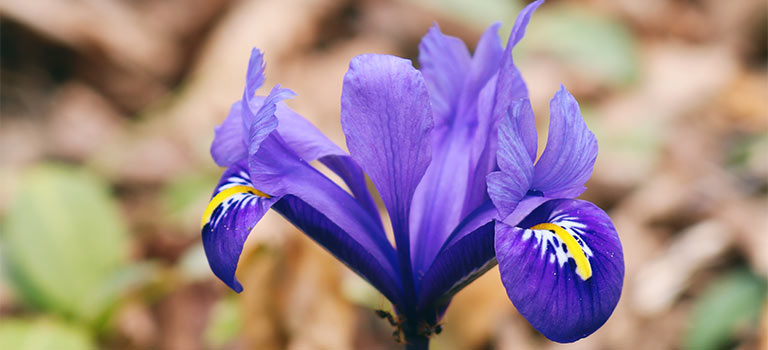
The Iris Family: More Than Meets the Eye
Rhizomatous Iris
Bearded: Plants have sword-shaped, usually broad leaves and simple or branched flower stems; bears multiple flowers, each with a prominent “beard” of white or colored hairs in the center of each fall (lower petal). The most common of the irises, bearded varieties are classified according to height and are planted so the rhizome pokes out above soil level.
Beardless: Do not have “beards”; rhizomes are planted just below ground level.
Siberian: Blue, purple, white, yellow, pink, or deep red flowers with large falls and smaller standards.
Laevigatae (a.k.a water irises): Simple stems bears blue, pink, red, purple, white, or yellow flowers.
Louisiana: Often have zigzag stems that bear flowers in large range of colors; prefers damp conditions.
Unguiculares: Evergreen, almost stemless plants bear blue, violet, lavender-pink, or white flowers from autumn to spring; develops from a mass of rhizomes aboveground.
Crested (a.k.a. Evansia irises): Relatively flat flowers in shades of blue, violet, or white that have a crest or ridge on each fall instead of a beard.
How Does Your Iris Grow?
Rhizome: A swollen length of underground stem that bears roots and leaves. A rhizome grows horizontally and forms roots on its underside while leaves sprout from the top. Buds form at intervals along the structure.
Bulb: Formed from the plant stem and leaves. The bottom of a bulb is made up of a small disk called the basal plate, which is a compressed stem. Roots grow from the bottom of the plate. Layers of scalelike leaf bases filled with food sit on the plate and surround a bud that will become the next year’s flower.
Pests and Diseases
Although most varieties are deer resistant, irises can attract a significant number of pests, including aphids, iris borers, iris weevils, slugs and snails, thrips, verbena bud moths, and whiteflies. The most significant of these pests, however, are iris borers, which chew on leaves and bore into the plant stems, leaving the plant wide open for soft rot, a foul-smelling bacterial infection that kills more plants than plants borers themselves actually do. The best way to avoid an infestation of borers is to keep the area around your irises clear of debris. If you notice any signs of infestation, dig up your plants and cut off and dispose of any infected parts, comb the soil for additional borers, and enlist the help of beneficial nematodes, which will destroy these pests.
How to Grow Iris
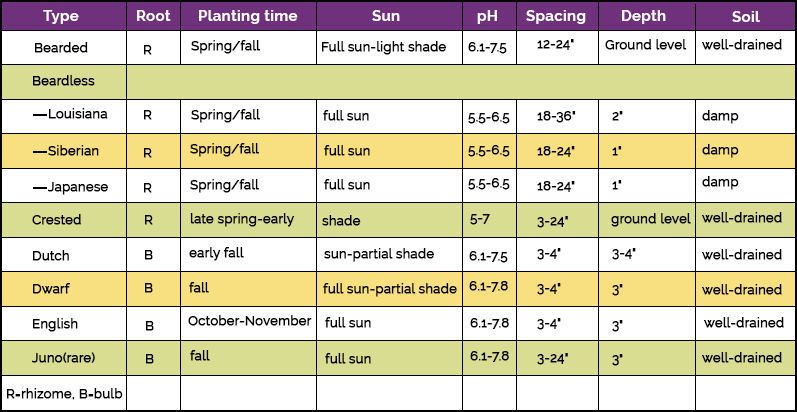
Bulbous Iris
Beardless flowers with deciduous leaves appear from late winter to midsummer.
Dutch: Slender, graceful flowers in a variety of blues and yellows, with broad, sword-shaped foliage.
Dwarf: Flowers are yellow, blue, white, or reddish violet; bulbs are covered with netted tunics.
Juno (Rare): Plants have flat or channeled leaves and grow from fleshy-rooted bulbs.
Iris Facts
- The Greek goddess, Iris, after whom the iris family of flowers was named, was also thought to be women’s guide to the underworld. Greeks planted purple irises over the graves of women to summon Iris to guide them on their journey.
- The iris is the basis for the fleur-de-lis, popularized during the |2th century by the French monarchy.
- Vincent Van Gogh did several paintings of irises, including one that sold at auction for $49 million, a then-record amount, in 1987. That painting was subsequently sold to the Getty Museum in Los Angeles.

